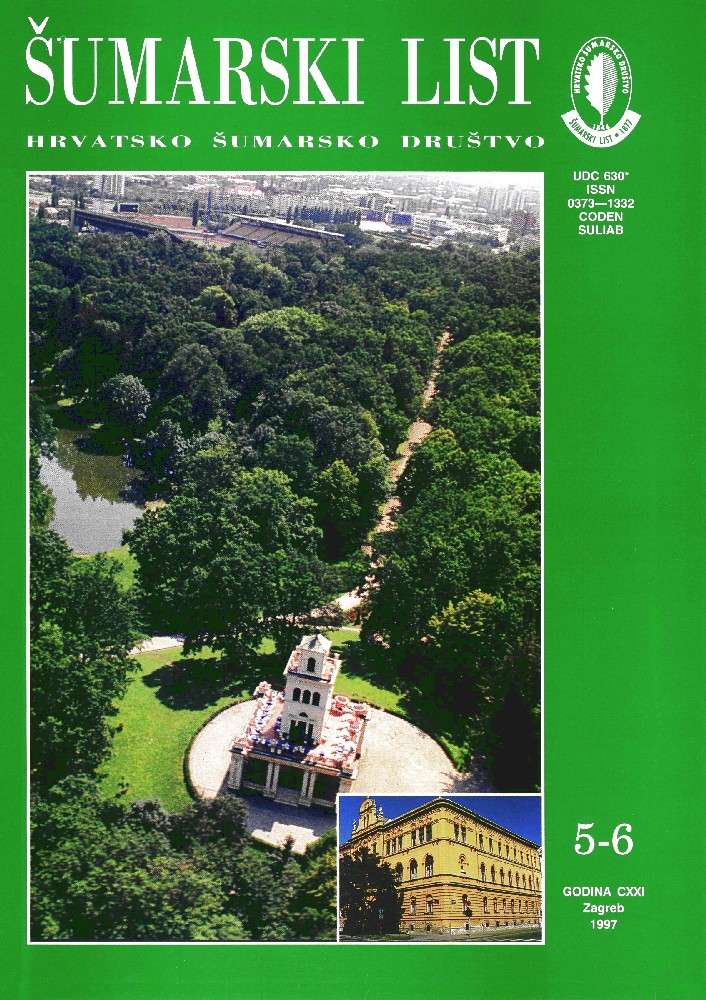
broj: 5-6/1997
pdf (31,9 MB) |
|
||||||||||||||
| IZVORNI ZNANSTVENI ČLANCI | ||
| Pintarić, K. | UDK 630* 231+236.001 (Pinus nigra Arn.) | |
| The Analysis of the Structure and Quality of the Natural Black Pine Young Growth pdf HR EN | 215 | |
| Summary: The shading impact of the parent stand tree crowns on the development, structure and quality of natural young growth has been investigated in the young growth (upper height about 2 m) of the natural Black Pine stand (Pinus nigraj, where wood is being exploited in the tree-by-tree way. The research was done on the test plots in which neither felling has been done for the last 15 to 20 years, nor the young growth tended. After the process of natural regeneration under the canopy of the parent stand has been initiated, a special regeneration period in the pure Black Pine stands should not last longer than 10 years, while the final cut should be carried out when the natural young trees reach the height of 0.5 m. Only exceptionally, if thicker trees are desired, some 15 to 20 trees of best quality should be left per one hectare, in which case these trees would be felled at the end of the second production period (rotation), in order to avoid the damage on the trees in the regenerated stand. The distance between these preserved specimens would be some 20 to 25 meters. Thus would an additional volume increment be obtained. An analysis of a naturally grown young black pine forest, in which tree-bytree cuts have been applied, has shown the following: 1. On cambisols, developed upon gabbros, natural regeneration is going on well, both under the protection of the tree crowns of the parent stand and by sideways gush of seeds (at about 2 to 3 tree heights of the parent stand). 2. As the Black Pine requires much light, a special regeneration period should not last longer than 10 years, or the height of the natural young growth should be about 0.5 m. 3. The average height of the young trees, depending on the shade degree, vary between 159 cm (the highest shade ) and 188 cm (the young tree has developed in full light). The upper heights ranged from 202 and 229 cm. Those young trees that had developed under the tree canopy, have decreased in growth in the last three years, while the ones with less shade displayed a tendency of increase. This conclusion has also been made as to the increment. 4. In the last four years, the least average height increment has been established with the highest degree of shade (9.8 cm), while the highest increment was achieved at full light (32 cm). Accordingly, three times higher increment has been established with full light. 5. The diameter increment is increasing with the higher intensity of light; the average width of the annual ring at full light is six times bigger than in deep shade. 6. Young trees of the approximately same height differ in age considerably. In the deepest shade, the average height was 22.4 years (Degree A), while at full light (Degrees E, F and G) it was 7 -9 years. This proves that the natural young growth comes from several seed years. 7. With higher light intensity, the number of trees becomes bigger, though not significantly, i.e. there are other factors. Other parameters also show the role of shade. The conclusion is that the natural young growth of the Black Pine does not come from a single seed year, but from as many as 10 years. The age difference of the young trees is bigger in case of higher shade, than with the young trees that have grown in full light (five years). | ||
| Matić, S., Prpić, B. | UDK 630* 272+249:630* 652+907.001 | |
| The Programme of Tending and Maintenance, the Ecological and Social Functions of the Zagreb Park Forest pdf HR EN | 225 | |
| Bojanin, S., Krpan, A. P. B. | UDK 630* 312+379:630* 419.001 | |
| Adjustement of the Skidding Technology to Forest Protection pdf HR EN | 243 | |
| Perić, Z. | UDK 630* 165.001 (Larix decidua Mill.) | |
| Interclonal and Clonal Differences in a Seed Orchard of European Larch (Larix decidua Mill.) near Bjelovar pdf HR EN | 253 | |
| Jurković, M., Jurković-Bevilacqua, B. | UDK 630* 175.272:181.2.001 | |
| The Contribution to the Introduction and Acclimatization of Exotic Woody Plants - Deciduous Trees in the Parks of Zagreb pdf HR EN | 269 | |
| PREGLEDNI ČLANCI | ||
| Đurasović, P. | UDK 630* 279:232.1 | |
| The Introduction of Exotic Trees and Shrubs in the Region of Dubrovnik pdf HR EN | 277 | |
| STRUČNI ČLANCI | ||
| Nekvapil, N. | UDK 630* 628 | |
| Forest Management of the "Bastaji Forest - Krivaja - Klisa" pdf HR EN | 291 | |


